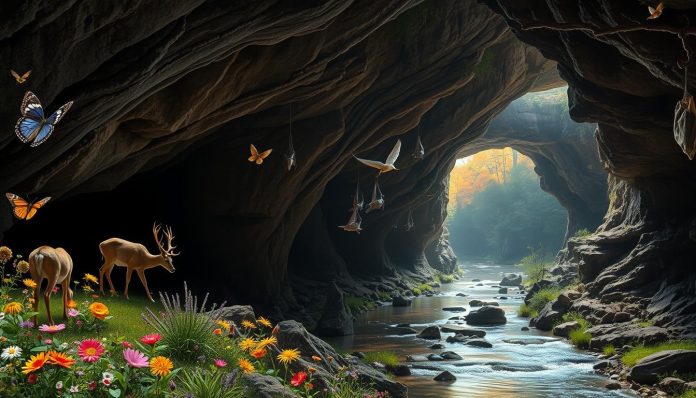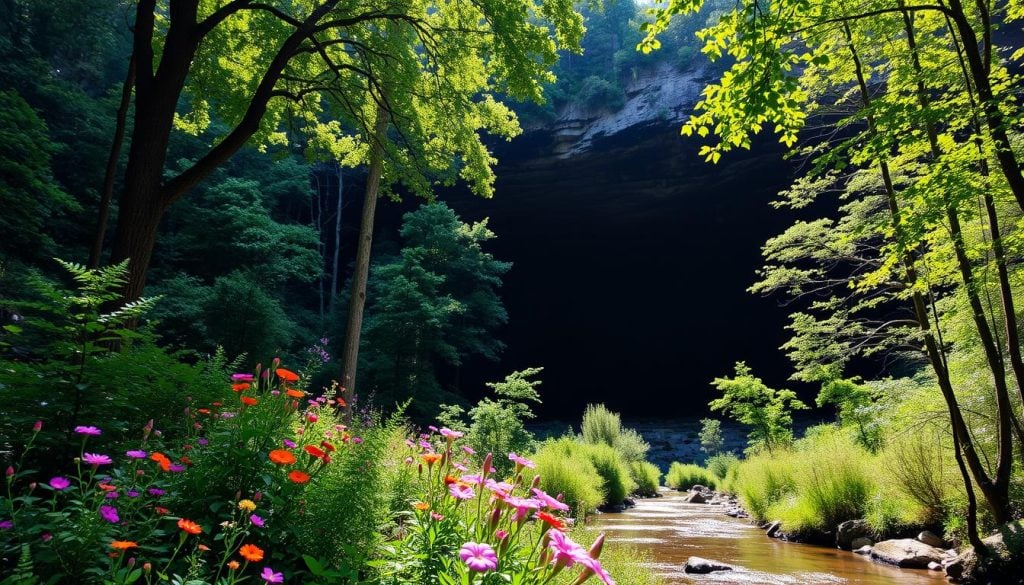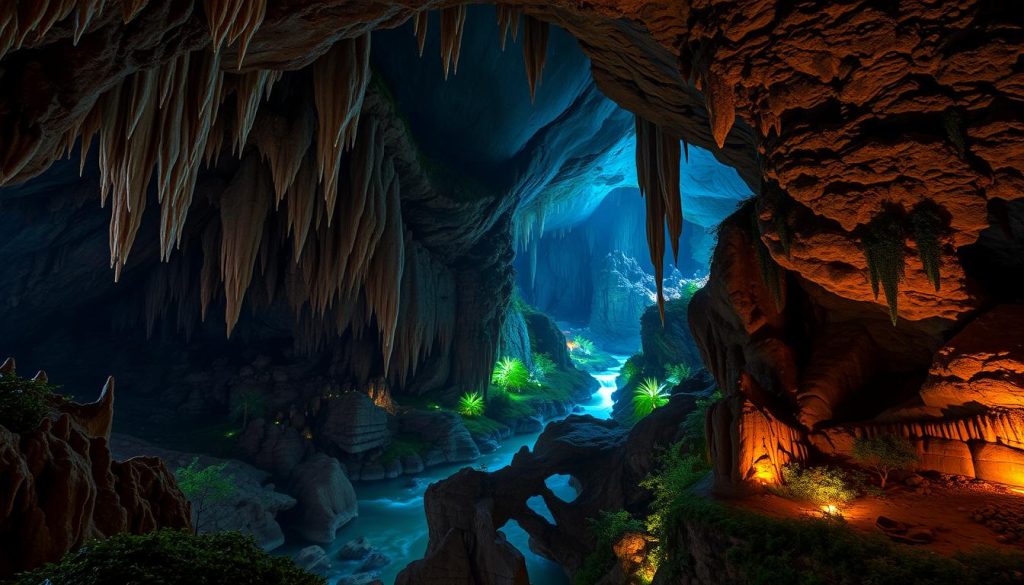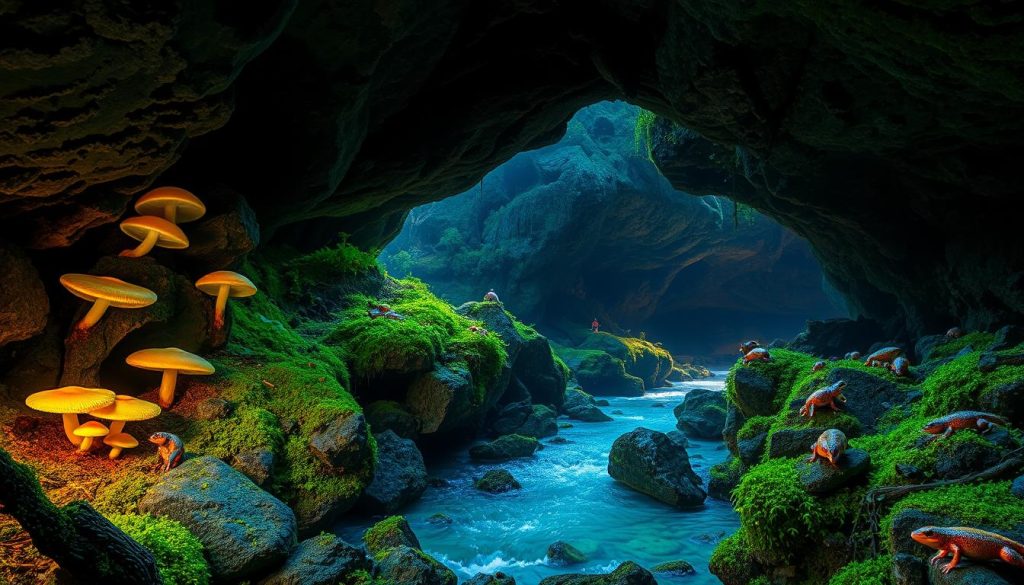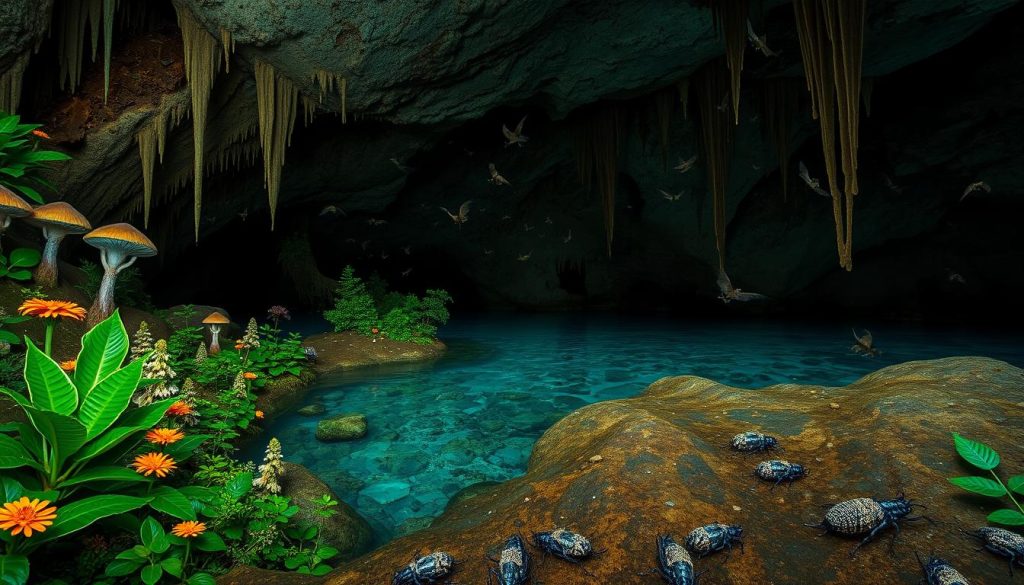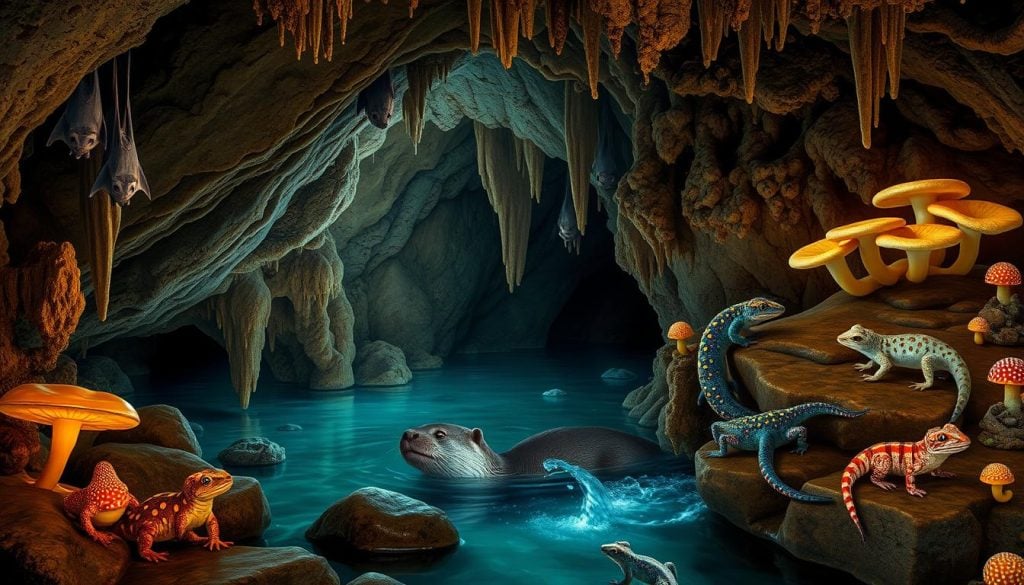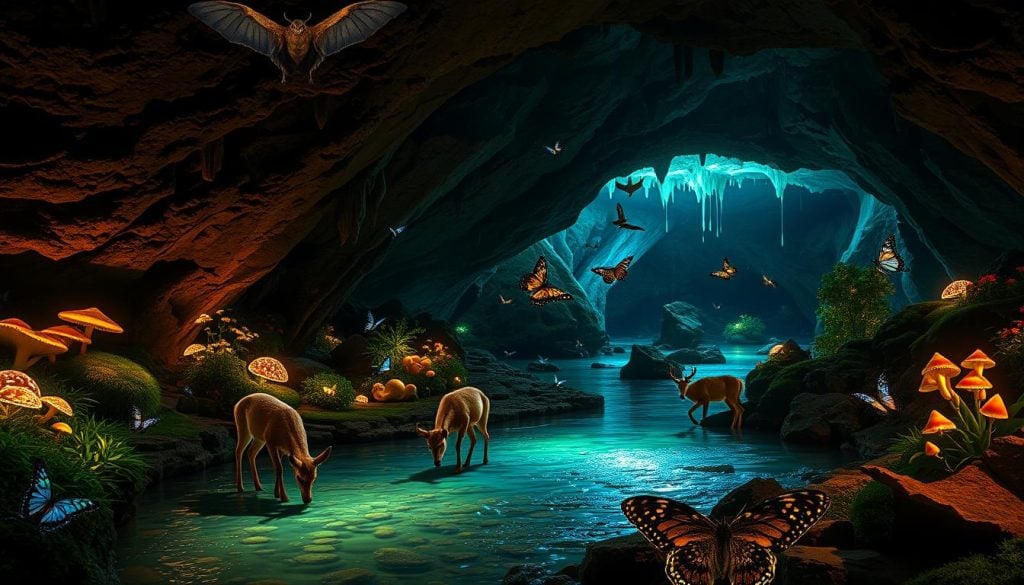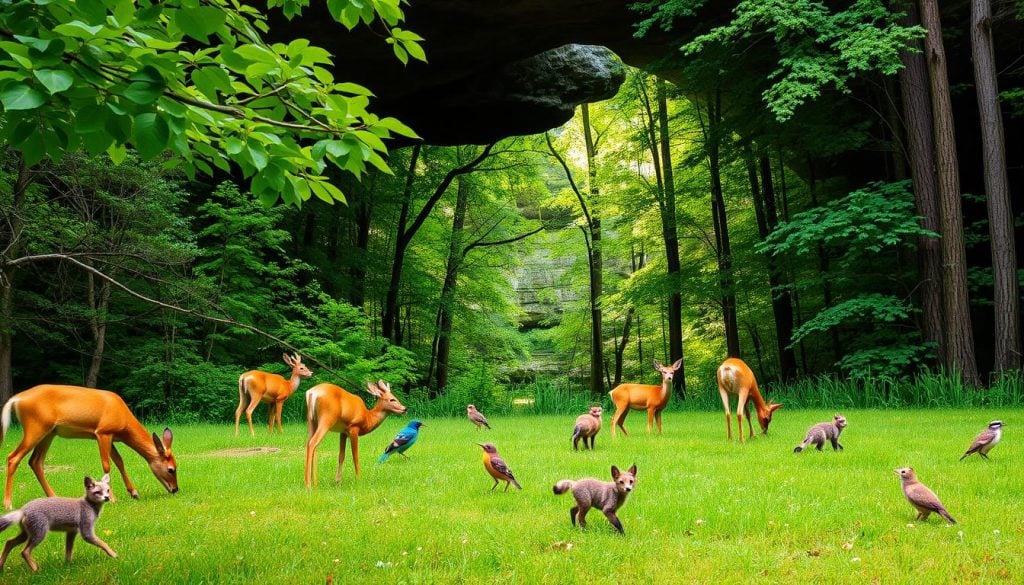Have you ever wondered what wildlife lives in Mammoth Cave National Park, beyond its caves? The park’s ecosystems are full of life, often overlooked but fascinating. This article will show you the amazing wildlife in Mammoth Cave and the special places they live. You’ll learn about rare and common animals, showing why wildlife in Mammoth Cave is truly special.
Introduction to Mammoth Cave National Park
Mammoth Cave National Park was created in 1941. It’s a key spot in Kentucky’s national parks. It’s famous for its huge underground tunnels, with over 400 miles explored. This makes it the longest cave system worldwide.
The park’s beauty under the earth attracts visitors from all over. The Mammoth Cave history is not just about its caves. For thousands of years, Native American communities lived here. Their history adds to the park’s story, mixing culture with nature.
At Mammoth Cave National Park, you can explore different worlds above and below ground. It’s a place where nature and history meet. It’s perfect for those who love nature, history, or adventure.
What Makes Mammoth Cave Unique?
Mammoth Cave is a standout natural wonder in the United States. It has over 400 miles of tunnels, making it the longest cave system globally. The cave’s limestone structure was shaped over millions of years by erosion and sediment.
Unlike most caves, Mammoth Cave is dry. This means you won’t see stalactites and stalagmites. Instead, it has rare minerals and gypsum formations that make it beautiful and intriguing. These geological wonders show the beauty of nature and the complex processes that shaped the cave.
Mammoth Cave is not just a geological site; it’s also home to diverse ecosystems. You’ll find a variety of plants and animals living here. The cave’s history, including stories of early explorers and Native American tribes, adds to its significance.
Exploring Wildlife in Mammoth Cave
Exploring wildlife in Mammoth Cave is a chance to see the park’s rich ecosystems up close. Each area has its own set of species that fit perfectly into their homes. Whether you’re underground or in the forests, you’ll see many kinds of wild animals.
The different landscapes support a wide variety of animals. You’ll find bats, deer, and many bird species. Activities like hiking, birdwatching, or joining guided tours help you learn about these animals and how they survive.
This adventure shows off the beauty of Mammoth Cave’s ecosystems. It also points out how nature’s balance supports life here. Walking through the park, you’ll see how animals, plants, and rocks work together in a special way.
What Wildlife Can Be Seen in Mammoth Cave National Park?
Exploring Mammoth Cave National Park reveals a wide variety of wildlife. You’ll see common animals and endangered species. The park’s different habitats support a rich variety of life, making it great for those who love wildlife.
Common Mammoth Cave Fauna
While visiting, you might see several common species. Some of these include:
- White-tailed deer
- Raccoons
- Squirrel species
- Various bird species like cardinals and woodpeckers
These animals are key to the park’s healthy ecosystem. They help keep Mammoth Cave’s natural world thriving.
Endangered Species Within the Park
The park is also home to endangered species like the Indiana bat. This bat is crucial for the cave’s balance. Seeing this rare bat and others, like the Kentucky cave salamander, makes the experience unique.
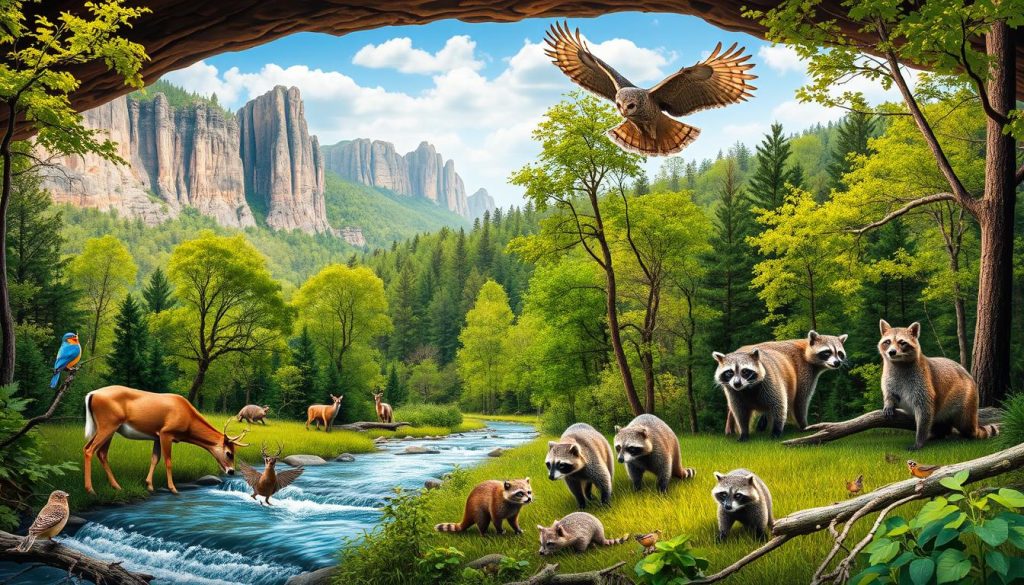
Protecting these endangered species is vital. It ensures Mammoth Cave National Park remains a great place for all its wildlife.
Biodiversity at Mammoth Cave
The biodiversity at Mammoth Cave is key to the health and balance of its ecosystems. These ecosystems are vital for both wildlife and visitors. They show the importance of nature’s balance.
The Ecosystem and Its Importance
Mammoth Cave is filled with many species, each adding something special to the ecosystem. These ecosystems provide important services like:
- Water filtration, ensuring clean water sources.
- Soil preservation, keeping lands fertile for plants.
- Habitat for various flora and fauna, keeping biodiversity high.
These services help wildlife and make the park beautiful for visitors. Understanding the value of biodiversity helps with conservation efforts.
Threats to Biodiversity in the Area
Even with its rich ecosystems, Mammoth Cave faces threats to its wildlife. These threats include:
- Habitat destruction from human actions, causing loss of homes.
- Pollution from farm runoff, harming water quality.
- Climate change, changing where species live and how ecosystems work.
It’s crucial to tackle these threats to protect Mammoth Cave’s ecosystems and their inhabitants. This way, future generations can also enjoy this natural treasure.
| Threat | Impact on Biodiversity | Potential Solutions |
|---|---|---|
| Habitat Destruction | Loss of species and genetic diversity | Implement stricter land-use regulations |
| Pollution | Degradation of water resources | Promote sustainable farming practices |
| Climate Change | Altered species distributions | Increase conservation awareness and action plans |
Primary Habitats Supporting Wildlife
Mammoth Cave National Park is known for its diverse habitats supporting wildlife. It has rich environments for many species. These habitats include vibrant forests and dynamic rivers. Both are key for keeping the park’s biodiversity.
Forest Ecosystems
The forest ecosystems in Mammoth Cave are full of life. They have many trees, shrubs, and plants. This variety is important for many animals.
Deer, foxes, and many birds live here. They find shelter and food in the forest’s layers.
River and Aquatic Habitats
The rivers and streams in the park are vital for aquatic life in Mammoth Cave. They are where fish and amphibians breed. This helps keep the park’s ecosystem balanced.
The mix of land and water shows how wildlife depends on each other. It’s why we must protect these places for the future.
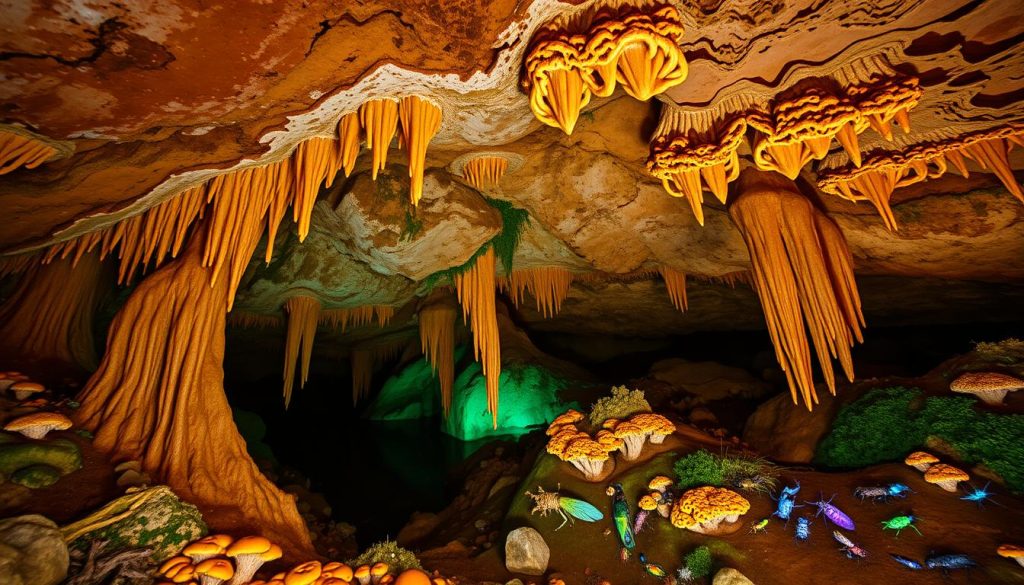
| Habitat Type | Features | Wildlife Supported |
|---|---|---|
| Forest Ecosystems | Diverse tree species, dense underbrush, and rich flora | Deer, foxes, various birds, squirrels |
| River Habitats | Running water, aquatic plants, and breeding grounds | Fish, amphibians, aquatic insects |
Animals in Mammoth Cave National Park
Mammoth Cave National Park is full of life. It’s home to a wide variety of animals. This makes it a great place for those who love nature. You’ll find many bird species and interesting mammals here.
Learning about their lives helps us understand the park’s ecosystem better.
Birds of Mammoth Cave
Over 100 bird species live in Mammoth Cave National Park. It’s a dream spot for bird lovers. You can see different birds, from those that migrate to those that stay all year.
Some birds you might see include:
- Barred Owl
- Indigo Bunting
- Wood Thrush
- American Woodcock
Exploring the park, whether by hiking or just sitting quietly, brings you closer to these birds.
Mammals and Their Habits
The mammals in Mammoth Cave play big roles in their environment. White-tailed deer are often seen, looking for food in the bushes. Coyotes are also here, showing off their varied skills in finding food.
Other mammals you might see are:
- Raccoons
- Eastern Cottontail Rabbits
- Red Foxes
- Little Brown Bats
Seeing these animals in the wild helps us value their roles in keeping the ecosystem balanced.
Mammoth Cave Wildlife Sightings
The vast wilderness of Mammoth Cave National Park is perfect for nature lovers. You can see many different animals in their natural homes. Visitors often talk about seeing deer, rabbits, and many bird species in the park.
Seasons change how easy it is to see wildlife. In spring and summer, many animals are out and about. Winter shows you animals that stay hidden most of the year. If you’re quiet and watchful, you might see animals easily.
Try visiting early in the morning or at dusk for the best wildlife spotting. This is when animals are most active. Keep an eye out and enjoy the beauty of nature.
Wildlife Watching at Mammoth Cave
Wildlife watching at Mammoth Cave lets you connect with nature deeply. Knowing when to spot wildlife makes your visit better. Early mornings and late afternoons are best for seeing animals.
Best Times for Spotting Wildlife
Some animals are easier to see at certain times and seasons. Knowing when to look can help you see more species. Here are some tips:
- Spring: Many animals wake up from hibernation.
- Summer: It’s great for seeing young animals and their families.
- Fall: Look out for birds starting their migration.
- Winter: Some animals stay active, while others are harder to find.
Guided Tours and Activities
Guided tours at Mammoth Cave make wildlife watching better. Park rangers lead these tours and share lots of knowledge. They teach you how to spot and identify animals.
These tours help you understand Mammoth Cave’s ecosystem better. It’s a great way to learn about the park’s wildlife.
Conclusion
Exploring wildlife in Mammoth Cave National Park gives us a peek into a world full of life. This place is home to a wide variety of species, showing us the beauty of nature’s balance. By learning about this ecosystem, we grow our love for the animals that live here.
Wildlife conservation is key, especially in a place like Mammoth Cave. Every visit helps us remember why we must protect these places for the future. As a visitor, you play a big part in keeping these habitats safe. Supporting conservation efforts helps protect this national treasure and all its creatures.
When you leave Mammoth Cave, think about what you’ve learned. This experience should make you more aware of how everything in nature is connected. Let this knowledge guide you to support wildlife preservation. Encourage others to see the beauty and importance of nature too.

































